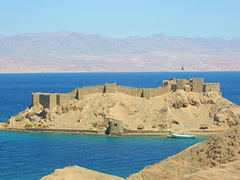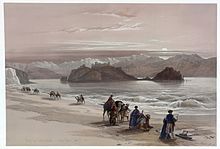Pharaoh's Island (Arabic: جزيرة فرعون Jazīrat Fir‘aun) is an island in the northern Gulf of Aqaba some 200 meters east off the shore of Egypt's eastern Sinai Peninsula. The island is 350 metres (380 yd) long north-south, and up to 170 metres (190 yd) wide. The area is 3.9 hectares (9.6 acres). Some scholars identify this island port with the biblical Ezion-Geber.[1]
History
Although the Crusaders reached the head of the Gulf of Aqaba in 1116, they did not take control of the oasis of Aila, which was in Muslim hands as late as 1154. In the early 1160s, the Crusaders allegedly built a castle on Pharaoh's Island but there is no evidence to support this.[2] The name île de Graye, by which the island and castle are commonly known, is a 19th-century invention from Arabic qurayya, "little village". Contemporary chronicles call it Aila, like the oasis.[3][4]
In December 1170, Saladin conquered the island and reconstructed the citadel and left a garrison of men there. In November 1181, Raynald of Châtillon raided the Arab-held Aila and attempted to set up a naval blockade against the Muslim troops there during the winter of 1182 to 1183. The blockade consisted of only two ships and was not successful. By the time of the 13th century, when the pilgrim Thietmar passed the island in 1217, the entire place was inhabited by a fishing village and populated by Muslims and captive. The Mamluk governor of the city of Aqaba lived in the citadel until some time in the 14th century, around 1320, when the seat of governorship was moved into the city itself.[3]
Modern Pharaoh's Island
Along with the citadel of El-Gendi Fortress, also on the Sinai Peninsula about halfway between Nekhel and Suez, the citadel on Pharaoh's Island was added onto the UNESCO World Heritage Tentative List on July 28, 2003, due to its purported universal cultural value.
Because of its location near Jordan and Israel, the island and its coral reefs have become a popular sightseeing attraction among tourists based in Taba, Eilat, and Aqaba.[5]
References
- ^ https://www.bible.ca/archeology/bible-archeology-exodus-kadesh-barnea-ezion-geber-jezirat-faraun-is-this-solomons-seaport-alexander-flinder-1989ad.htm
- ^ "On Islomania". Retrieved 18 August 2020.
- ^ a b Pringle, Denys (2006). "Aila and Ile de Graye". In Alan V. Murray (ed.). The Crusades: An Encyclopedia. 1. Santa Barbara: ABC-CLIO. p. 23. OCLC 70122512.
- ^ Hugh Kennedy, Crusader Castles (Cambridge, 1994), p. 30.
- ^ Al-Mukhtar, Rima (23 November 2012). "Sharm El-Sheikh, city of peace". Arab News. Retrieved 23 May 2018.
External links
- Sinai's Lifestyle & Travel Guide information
- Geographia information
- Two citadels in Sinai from the Saladin period (Al-Gundi and Phataoh's island) - UNESCO World Heritage Centre Retrieved on 2008-03-19.

